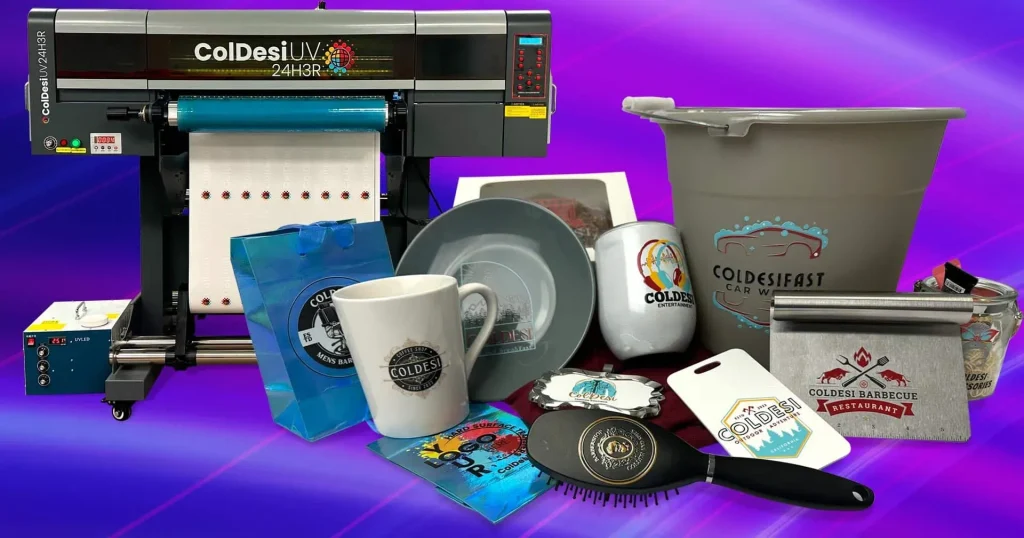In recent years, UV DTF printing has emerged as a groundbreaking technique in the world of sustainable printing. This innovative method utilizes ultraviolet (UV) light to instantly cure inks during the printing process, resulting in vibrant colors and high-quality outputs. As companies strive to reduce their environmental impact, UV DTF printing stands out for its low emissions of volatile organic compounds (VOCs) and energy-efficient LED UV curing technology. Moreover, this eco-friendly printing technology minimizes waste by applying ink precisely, making it an attractive option for brand owners and manufacturers alike. In this blog post, we will delve into the numerous benefits of UV DTF printing and its pivotal role in promoting sustainable practices in the printing industry.
Known alternatively as UV direct-to-film printing, this cutting-edge technique integrates eco-friendly printing technologies to enhance the overall efficiency and sustainability of the printing process. By leveraging UV inks that cure through exposure to UV light, this method not only achieves striking visual results but also significantly reduces the environmental impact of printing operations. With its growing popularity, the transition to this innovative practice highlights a broader commitment within the industry towards responsible and sustainable manufacturing. As we explore this topic, we will uncover how UV DTF printing represents a significant shift in reducing waste and emissions, paving the way for a greener future in the realms of commercial and artistic printing.
Understanding the Benefits of UV DTF Printing
UV DTF printing offers a compelling alternative to traditional printing methods, particularly when it comes to sustainability. This modern technique employs UV-curable inks that do not emit harmful volatile organic compounds (VOCs) during the printing process. As a result, the air quality in production facilities improves markedly, providing a healthier environment for workers. Furthermore, the vivid colors and high-resolution prints achievable with UV DTF technology set a high standard in the marketplace, aligning with the aesthetic demands of customers while maintaining eco-friendly practices.
Another significant advantage of UV DTF printing is its versatility across various substrates, including textiles, plastics, metals, and more. This flexibility allows businesses to innovate in their product offerings without the environmental ramifications associated with traditional printing methods. The quick curing process not only enhances efficiency but also reduces material waste, empowering businesses to maintain a lean manufacturing model. Adopting UV DTF printing aligns perfectly with the sustainable trends that modern consumers are increasingly favoring.
Eco-Friendly Aspects of UV DTF Printing
The eco-friendliness of UV DTF printing stems from its use of advanced technologies that drastically reduce the environmental impact associated with ink production and application. Unlike conventional printing techniques that often involve solvent-based inks, the UV DTF process utilizes UV inks that cure instantly when exposed to ultraviolet light, minimizing waste by applying ink more precisely to the substrate. This results in significantly lower waste and a reduced carbon footprint, making it a credible choice for companies looking to improve their sustainability initiatives.
Additionally, many manufacturers are increasingly adopting LED UV curing systems as part of their UV DTF printing process. This advancement decreases energy consumption by up to 70% compared to traditional curing methods, directly contributing to a smaller environmental footprint. The shift towards such technologies aligns with the growing demand for sustainable printing solutions in various industries, reinforcing the notion that UV DTF printing represents a forward-thinking approach to eco-friendly production.
Waste Reduction Techniques in UV DTF Printing
A key advantage of UV DTF printing is its inherent ability to reduce waste actively. This printing technique minimizes excess material usage through its precise application of inks, which allows businesses to optimize their resources effectively. By significantly cutting down on overproduction and defective prints, manufacturers can ensure that they are producing only what is needed, thereby lowering overall waste.
Moreover, the use of transfer films in the UV DTF process eliminates the need for multiple print runs, which is often necessary in traditional printing methods. This aspect not only conserves materials but also accelerates the overall production time. As printing companies adopt more sustainable practices, the capability to effectively manage waste through UV DTF printing will play a pivotal role in promoting a more sustainable industry.
The Impact of UV Inks on Environmental Sustainability
UV inks play a crucial role in enhancing the environmental sustainability of printing processes. These inks, when cured with UV light, solidify immediately, resulting in little to no volatile emissions. This contrasts sharply with water-based or solvent-based inks, which can release harmful VOCs into the environment during application. The transition to UV inks helps decrease the printing industry’s overall contribution to air pollution, supporting cleaner, healthier communities.
Furthermore, the longevity and durability of UV inks are significant factors in their ecological advantages. The greater resistance to fading and degradation means that printed materials remain vibrant and usable for longer periods, reducing the need for frequent reprints. This durability not only offers businesses cost savings but also aligns with the growing demand for long-lasting solutions in an era where sustainability is paramount.
How LED UV Curing Innovates Sustainable Printing
The introduction of LED UV curing technology within UV DTF printing represents a game-changer for sustainable practices in the industry. This innovative technology utilizes light-emitting diodes (LEDs) that require far less energy to operate compared to traditional UV curing methods. By drastically reducing energy consumption, LED UV curing aligns with broader environmental goals of minimizing carbon footprints across manufacturing sectors.
In addition to energy savings, LED technology also offers extended lamp life, reducing the frequency of replacements. This longevity not only contributes to lower operational costs for printing companies but also minimizes waste associated with discarded UV lamps. As the printing industry continues to embrace LED UV curing, the potential for collective environmental benefits is substantial, reinforcing the commitment to eco-friendly practices.
Future Trends in Sustainable Printing Technologies
The printing industry is at a pivotal moment where sustainability is becoming a primary focus for innovation. As companies continue exploring methods to reduce their environmental impact, trends towards integrating biodegradable materials, water-based inks, and eco-conscious manufacturing practices are on the rise. This shift responds to consumer demands for more sustainable products, promoting an industry-wide commitment to ecological responsibility.
Research and insights from industry leaders suggest that the future of sustainable printing will increasingly feature technologies that minimize waste and energy consumption. As businesses adopt practices that prioritize eco-friendliness, advancements in areas like UV DTF printing will undoubtedly be at the forefront, leading the charge towards a more sustainable future in the printing sector.
Frequently Asked Questions
What are the environmental benefits of UV DTF printing compared to traditional methods?
UV DTF printing significantly reduces environmental impacts through lower emissions of volatile organic compounds (VOCs) due to the use of UV-curable inks. These inks release fewer pollutants, improving air quality and minimizing health risks. Moreover, UV DTF printing is more energy-efficient, especially with LED UV curing technologies that cut energy usage by up to 70% compared to traditional UV systems.
How does UV DTF printing contribute to sustainable printing practices?
UV DTF printing contributes to sustainable printing by minimizing waste and using precise ink applications, which reduces excess material usage. This technology eliminates the need for multiple print runs and promotes the adoption of biodegradable inks and substrates, aligning with eco-friendly printing technologies.
What role do UV inks play in eco-friendly printing technologies?
UV inks are crucial in eco-friendly printing technologies as they cure instantly when exposed to UV light, leading to lower VOC emissions and enhanced color vibrancy. With advancements in curing processes, such as LED UV curing, these inks reduce energy consumption, making UV DTF printing a sustainable alternative to solvent-based inks.
Why is LED UV curing important for the environmental impact of UV DTF printing?
LED UV curing technology is essential for reducing the environmental impact of UV DTF printing because it uses up to 70% less energy than traditional UV curing methods. This substantial energy savings helps lower the carbon footprint of printing operations, making them more sustainable while maintaining high-quality output.
Can UV DTF printing be considered a sustainable choice for promotional materials?
Yes, UV DTF printing is increasingly recognized as a sustainable choice for promotional materials due to its reduced environmental impact through lower VOC emissions and efficient energy use. The method’s ability to produce high-quality images with less waste makes it an attractive option for businesses aiming to enhance their sustainability practices.
What makes UV DTF printing a versatile option for different substrates?
UV DTF printing is versatile because it can effectively print on a wide range of substrates, including textiles, plastics, and metals. This adaptability, combined with its eco-friendly ink options and energy-efficient curing processes, positions UV DTF printing as a sustainable solution for various printing needs.
| Key Point | Details |
|---|---|
| What is UV DTF Printing? | A modern printing technique using UV-curable inks on a film substrate, providing high-quality images and quick production times. |
| Advantages | 1. High-Quality Output: Exceptional image quality for branding. 2. Versatility: Usable on various substrates (textiles, plastics, metals). 3. Quick Turnaround: Instant curing allows for faster speeds. |
| Lower VOC Emissions | Compared to traditional printing, UV DTF printing uses inks with lower volatile organic compound emissions, improving air quality. |
| Energy Efficiency | LED UV curing systems are more energy-efficient, significantly lowering carbon footprints while maintaining quality. |
| Waste Reduction | Precise ink application reduces excess material usage, leading to less waste, and the use of films minimizes the need for multiple print runs. |
| Industry Trends | Growing adoption of eco-friendly practices with a focus on biodegradable inks, recyclable substrates, and safer printing methods like water-based inks. |
Summary
UV DTF printing is emerging as a sustainable choice in the printing industry, demonstrating significant advantages in environmental impact. This modern printing method reduces emissions of volatile organic compounds (VOCs), ensuring a healthier workplace and environment. Additionally, innovations such as LED UV curing technology enhance energy efficiency, allowing for lower carbon footprints. The capability of UV DTF printing to minimize waste through precise ink application further emphasizes its eco-friendliness. As businesses increasingly prioritize sustainability, UV DTF printing stands at the forefront of responsible manufacturing, potentially transforming industry practices for a greener future.



